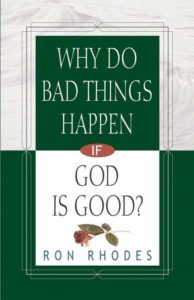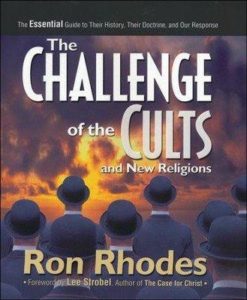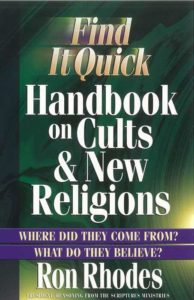Is Evil an Illusion?

Some religious groups today claim that the present world we perceive with our five senses is an illusion. The way to recognize and overcome this illusion is to follow certain religious teachings. These groups include Hinduism and Christian Science. Let us consider a few details.
The Illusory World of Hinduism
Hinduism, as a religion, is monistic (“all is one”) and pantheistic (“all is God”). Because of this, Hindus believe that distinctions between things in our world are ultimately unreal. When one perceives distinctions between things, it is nothing more than a mental illusion (maya). Hence, contrary to what may seem to be the case in day-to-day living, you and I are not individuals who are distinct from the impersonal god that underlies all reality, which Hindus call Brahman. The entire world is viewed as “Brahman in disguise.”[1] All is God.
Hindus believe that the big problem for human beings is that they are ignorant of their divine nature. They have forgotten that they are extended from Brahman. “Humans have a false knowledge (maya) when they believe that this life and our separation from Brahman are real.”[2]
As a remedy, Hindus tell us, people have become subject to the law of karma, which is basically a cosmic law of cause and effect. You reap in the next life—via reincarnation—what you sow in the present life. If you do good things in the present life, you will be born in a better state in the next life. Likewise, if you do bad things in the present life, you will be born in a worse condition in the next life.
Liberation from this continual cycle of rebirths is called moksha. This liberation comes through the enlightened realization that the very idea of an individual self is maya (an illusion), and that only undifferentiated oneness with Brahman is real. When a person comes to this realization (after many reincarnations), one can be freed from the continual cycle of rebirths and achieve ultimate unity with Brahman.
Now, here is the crucial part to remember: What we perceive with our physical senses is an illusion or a dream. Because “all is one” and “all is God,” there is no real difference between good and evil. We should therefore not be concerned about the existence of evil. It is maya.
The Illusory World of Christian Science
Mary Baker Eddy, the founder of Christian Science, derived most of her theology from Phineas P. Quimby, a metaphysical writer whose views eventually gave rise to the New Thought Movement in the 1800s. Quimby believed that sin, sickness, and disease exist only in the mind. He believed that by following his New Thought techniques, people could correct their wrong thinking and eradicate these things from their lives.
Some nine years after Quimby died, in 1875, Eddy published her book Science and Health with Key to the Scriptures, and only mentioned Quimby in passing. In this book, Eddy set forth the metaphysical principles she learned from Quimby but did not give him credit.
One of the central teachings of this book is that sin, evil, sickness, and death are mere illusions that can be conquered by denying them. Evil, sickness, and death are said to be “states of false belief.”[3] The only reality that truly exists is God or “Divine Mind.” Since matter does not genuinely exist, neither can sickness, pain, death, or evil genuinely exist. “The cause of all so-called disease is mental, a mortal fear, a mistaken belief or conviction of the necessity and power of ill-health.”[4] By following Christian Science techniques, Eddy claimed, these mental errors—these “illusions” that include sickness and death—can be conquered.
Assessing the Worldview of Illusion
Self-Contradictory. Evil is quite real. To suggest that evil is not real is itself evil since it misleads people. To suggest that sin is not real is itself sinful since it misleads people. To suggest that death is not real is itself deadly since people who believe in this idea make no preparations for the afterlife (via faith in Christ for salvation). The worldview of illusion is deeply deceptive.
The Origin of the Illusion. Where did the illusion of sin, sickness, death, and evil come from? If all is God—and if matter is unreal—then when and where did this widespread, universal delusion emerge? What is the source of this “mental error”? If all is God, as Christian Science claims, then logically this error must be part of God himself. But how can that be? And if it is not of God, then clearly all reality cannot be said to be God. Such inconsistency undermines the worldview of illusion.
The Harsh Reality of Sickness and Death. Mary Baker Eddy claimed that sickness and death are illusions. It is a historical fact, however, that in her declining years Eddy was under a doctor’s care, received morphine injections to ease her pain, wore eyeglasses to correct bad eyesight, had teeth extractions, and eventually died, thus undermining all she professed to believe and teach. Though Christian Science claims sickness and death are false beliefs, the reality is that Christian Science itself is a false belief that can cause the very suffering it feebly tries to deny.
The Worldview of Illusion Is Not Livable. When Hindus and proponents of Christian Science claim evil is an illusion, it is fair game to ask them if they lock their front doors at night. (If they do, ask them why?) Do they leave their keys in the ignition when the car is parked downtown on Main Street? (If not, why not?) Do they buckle their seat belts in the car? (Why?) Do they go to the dentist? (Why? Tooth pain is an illusion, right?) Do they put life vests on their little children when they swim in the ocean? (Why?) Do they warn their little children not to get too close to the fire at the cookout? (Why?) Do they support laws against pedophiles? (Why?) If evil is an illusion, then such things are entirely unnecessary and should be of no concern to anyone. This is not a livable worldview.
The Inadequacy of Pantheism and Monism. I had the opportunity to converse with former Hindu guru Rabi Maharaj. He spoke at length of the ethical dissatisfaction he had felt as a Hindu regarding a monistic (“all is one”) and pantheistic (“all is God”) worldview, especially as it pertained to the problem of evil. He said:
My growing awareness of God as the Creator, separate and distinct from the universe he had made, contradicted the Hindu concept that God was everything, that the Creator and the Creation were one and the same. If there was only One Reality, then [God] was evil as well as good, death as well as life, hatred as well as love. That made everything meaningless, life an absurdity. It was not easy to maintain both one’s sanity and the view that good and evil, love and hate, life and death were One Reality.[5]
Rabi made the only logical choice and became a Christian!
Christian Scripture Validates the Need for Empirical Evidence. Scripture often encourages us to pay attention to empirical evidence using our five senses. Jesus told doubting Thomas to stick his fingers into His crucifixion wounds as a way of proving to Thomas that indeed He had risen from the dead (John 20:27). In Luke 24:39, the resurrected Jesus told His followers, “Look at my hands and my feet. It is I myself! Touch me and see; a ghost does not have flesh and bones, as you see I have.” We read in 1 John 1:1, “That which was from the beginning, which we have heard, which we have seen with our eyes, which we have looked at and our hands have touched—this we proclaim concerning the Word of life.” The same senses that so convincingly testify to the resurrected Christ testify to the reality of evil in our world.
My friends, we may give thanks to God that in the pages of the Bible we find a coherent view of reality that makes sense of the problem of sin, sickness, death, and evil.
Some of the content of this article is derived from four of Ron Rhodes’ books, each of which may be consulted for further study:
Why Do Bad Things Happen If God Is Good (Harvest House Publishers, 2004).
The Challenge of the Cults and New Religions (Zondervan Publishers, 2009).
Find It Quick Handbook on Cults and New Religions: Where Did They Come From? What Do They Believe? (Harvest House Publishers, 2005).
World Religions: What You Need to Know (Harvest House Publishers, 2007).
Go Deeper
- God’s Word to the World
- Did Jesus Literally Rise from the Dead?
- The Historical Evidence for the Resurrection Even the Skeptics Believe
- Mark Albrecht, “Hinduism,” in Evangelizing the Cults, ed. Ronald Enroth (Ann Arbor: Servant, 1990), p. 22. ↑
- Lewis M. Hopfe, Religions of the World (New York: Macmillan, 1991), p. 98. ↑
- Mary Baker Eddy, Unity of Good (Boston: Trustees under the Will of Mary Baker G. Eddy, 1908), p. 50. ↑
- Mary Baker Eddy, Science and Health with Key to the Scriptures (Boston: Trustees under the Will of Mary Baker G. Eddy, 1934), p. 377. ↑
- Rabi Maharaj, “Death of a Guru,” Christian Research Newsletter, 3:3, p. 2. ↑











